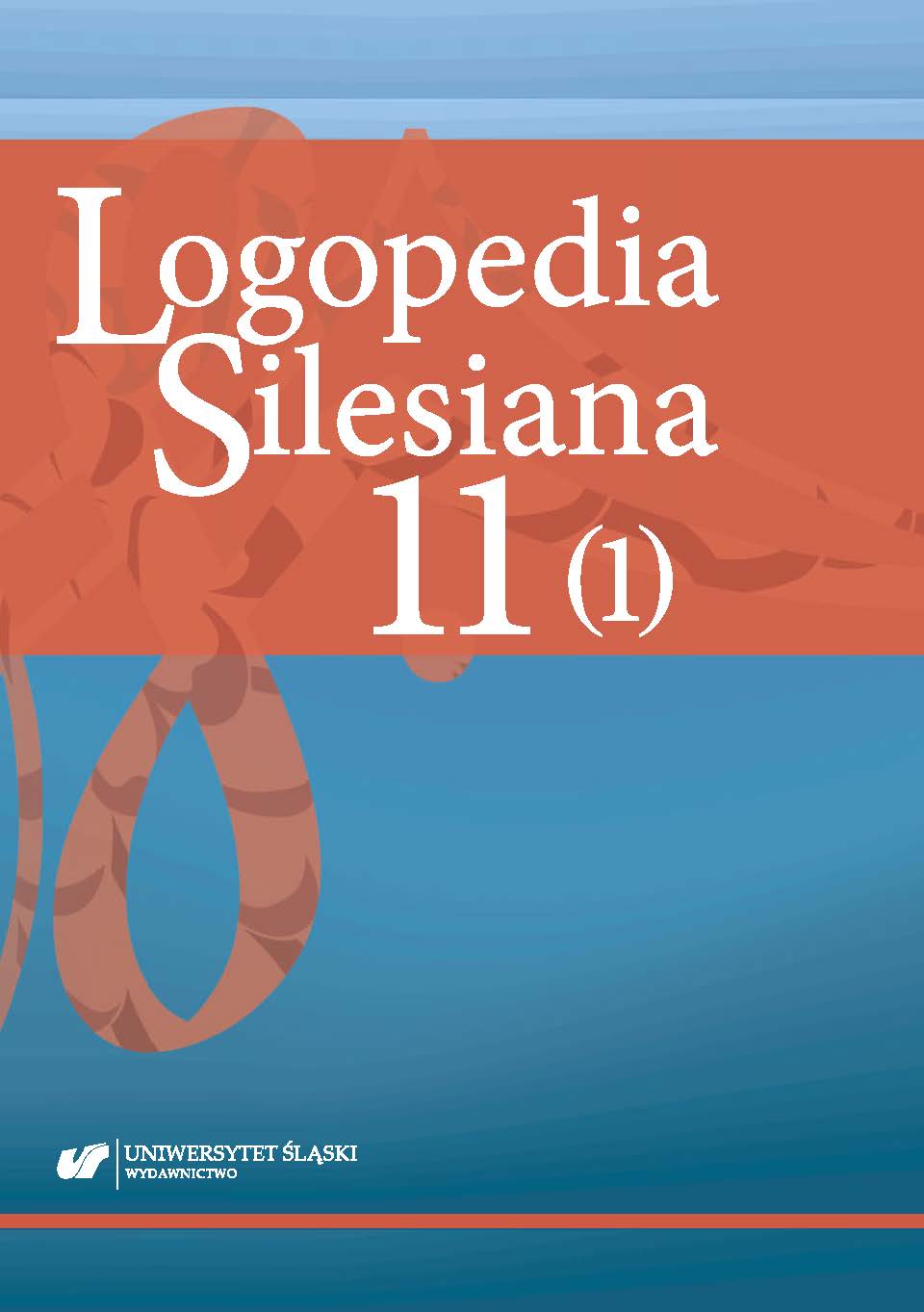Audag, N., Goubau, C., Toussaint, M., Reychle, G. (2016). Screening and evaluation tools of dysphagia in children with neuromuscular diseases: A systematic review. Developmental Medicine and Child Neurology, 9(6), 591–596. https://doi.org/10.1111/dmcn.13354.
Google Scholar
Błeszyński, J., Brzozowska-Misiewicz, I., Twardo, M. (2016). Zarys terapii logopedycznej dzieci z zespołami wad wrodzonych. Wczesna interwencja logopedyczna. Gdańsk: Wydawnictwo Harmonia.
Google Scholar
Boksa, E. (2016). Dysfagia z perspektywy zaburzeń komunikacji językowej u dzieci i młodzieży z niepełnosprawnościami sprzężonymi. Kraków: Libron.
Google Scholar
Dharmarathna, I., Miles, A., Allen, J. (2019). Twenty years of quantitative instrumental measures of swallowing in children: a systematic review. European Journal of Pediatrics, 179, 203–223. https://doi.org/10.1007/s00431-019-03546-x.
Google Scholar
García-Torres, E. et al. (2019). Vocal cord paralysis after cardiovascular surgery in children: Incidence, risk factors and diagnostic options. European Journal of Cardio-Thoracic Surgery, 57, 359–365. https://doi.org/10.1093/ejcts/ezz190.
Google Scholar
Gawlik, M., Kurdas, D. (2014). Zasady walidacji kwestionariuszy na przykładzie kwestionariusza Caregiver Quality of Life-Cancer. The Central European Journal of Social Sciences and Humanities, 3, 26–29. http://cejsh.icm.edu.pl/cejsh/element/bwmeta1.element.desklight-494f824f-d03c-44dc-9d4b-f5053cb0c0a4.
Google Scholar
Ha, J. (2020). Unilateral vocal fold palsy & dysphagia: A review. Auris Nasus Larynx, 47, 315–334. https://doi.org/10.1016/j.anl.2020.03.001.
Google Scholar
Hamadah, H.K., Kabbani, M.S. (2017). Bedside ultrasound in the diagnosis and treatment of children with respiratory difficulty following cardiac surgery. Journal of Clinical Imaging Science, 7(37), 1–13. https://doi.org/10.4103/jcis.JCIS_42_17.
Google Scholar
Horton, J., Atwood, C., Gnagi, S., Teufel, R., Clemmens, C. (2018). Temporal trends of pediatric dysphagia in hospitalized patients. Dysphagia, 33(5), 655–661. https://doi.org/10.1007/s00455-018-9884-9.
Google Scholar
Jabbour, J., Uhing, M., Robey, T. (2017). Vocal fold paralysis in preterm infants: prevalence and analysis of risk factors. Journal of Perinatology, 37(5), 585–590. https://doi.org/10.1038/jp.2016.263.
Google Scholar
Jabłońska-Jesionowska, M., Zawadzka-Głos, L. (2019). Diagnostic evaluation of congenital respiratory stridor in children. New Medicine, 1, 3–13. https://doi.org/10.25121/NewMed.2019.23.1.3.
Google Scholar
Knapek, M. (2020). Anatomiczne i fizjologiczne uwarunkowania opóźnionego rozwoju mowy oddychanie i fonacja. Forum Logopedy, 39, 5–9.
Google Scholar
Machoś, M., Czajkowska M. (2019). Ssanie bez tajemnic. Zabrze: Wydawnictwo GooGoo.
Google Scholar
Machoś-Nikodem, M. (2018). Diagnoza neurologopedyczna niemowlęcia od 1 do 12 miesiąca życia. Bytom: Wydawnictwo Ergo-Sum.
Google Scholar
Mielnik-Niedzielska, G. (2016). Dysfagia u dzieci. Otorynolaryngologia, 15(2), 63–67. https://www.otorynolaryngologia-pk.pl/f/file/orl-16-2-2.pdf.
Google Scholar
Narożny, W., Szmaj, M. (2014). Zaburzenia mowy w dysfagii. W: S. Milewski, J. Kuczkowski,
Google Scholar
K. Kaczorowska-Bray (red.). Biomedyczne podstawy logopedii. Gdańsk: Wydawnictwo Harmonia.
Google Scholar
Nguyen, S., et al. (2016). Dysphagia after cardiac operations is associated with increased length of stay and costs. American Surgery, 82(10), 890–893. https://doi.org/10.1177/000313481608201006.
Google Scholar
Obrębowski, A. Wiskirska-Woźnicka, B. Obrębowska, Z. (2018). Zaburzenia połykania w praktyce neurologopedycznej. W: A. Obrębowski (red.). Wprowadzenie do neurologopedii. Poznań: Termedia.
Google Scholar
Pusz, B. (2016). Wczesna interwencja i stymulacja dziecka na oddziale neonatologicznym. Gdańsk: Wydawnictwo Harmonia.
Google Scholar
Pluta-Wojciechowska, D. (2009). Połykanie jako jedna z niewerbalnych czynności kompleksu ustno-twarzowego. Logopedia, 38, 119–147.
Google Scholar
Przybyla, O. (2015). Postępowanie logopedyczne w przypadku noworodków i niemowląt. W: S. Grabias, T. Woźniak, J. Panasiuk (red.), Logopedia. Standardy postępowania logopedycznego. Lublin: Wydawnictwo Uniwersytetu Marii Curie-Skłodowskiej.
Google Scholar
Regner, A. (2016). Wczesna interwencja logopedyczna zapobiegająca zaburzeniom ustno-twarzowym. Wczesna interwencja logopedyczna. Gdańsk: Wydawnictwo Harmonia.
Google Scholar
Rządzka, M. (2018). Wczesna interwencja logopedyczna u noworodków i niemowląt. Kontekst diagnostyczno-terapeutyczny. Wprowadzenie do neurologopedii. Poznań: Termedia
Google Scholar
Rządzka, M. (2019). Odruchy oralne u noworodków i niemowląt. Diagnoza i stymulacja. Kraków: Impuls.
Google Scholar
Saunders, N., et al. (2013). Guidance on the development and validation of diagnostic tests that depend on nucleic acid amplification and detection. Journal of Clinical Virology, 56, 260–270. https://doi.org/10.1016/j.jcv.2012.11.013.
Google Scholar
Speyer, R., Cordier, R., Parsons, R., Denman, D., Kim, J.H., (2018). Psychometric characteristics of non-instrumental swallowing and feeding assessments in pediatrics: A systematic review. Dysphagia 33, 1–14. https://doi.org/10.1007/s00455-017-9835-x.
Google Scholar
Stoudemire, W., Fordham, L.A., Vece, T.J. (2018). Diagnosis and treatment of pediatric dysphagia: Radiography. W: Ongkasuwan, J., Chiou, E. (red.), Pediatric dysphagia. Cham: Springer. https://doi.org/10.1007/978-3-319-97025-7_9.
Google Scholar
Tomik, J., Solowska, B. (2015). Zaburzenia połykania. Neurolingwistyka Praktyczna, 1, 27–41.
Google Scholar


 https://doi.org/10.31261/LOGOPEDIASILESIANA.2022.11.01.05
https://doi.org/10.31261/LOGOPEDIASILESIANA.2022.11.01.05

 10.31261/LOGOPEDIASILESIANA
10.31261/LOGOPEDIASILESIANA